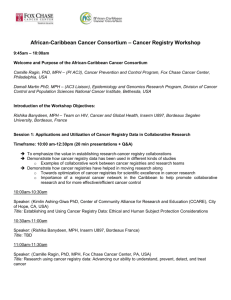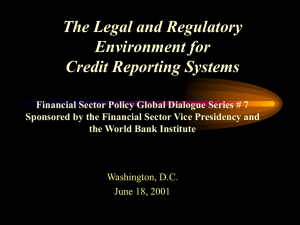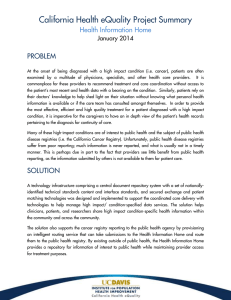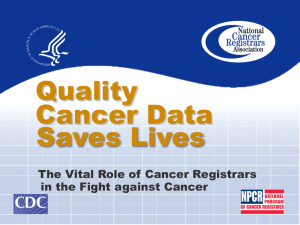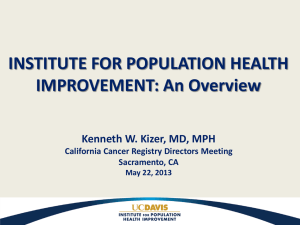Discovery of Web Services in a Federated Registry Environment
advertisement
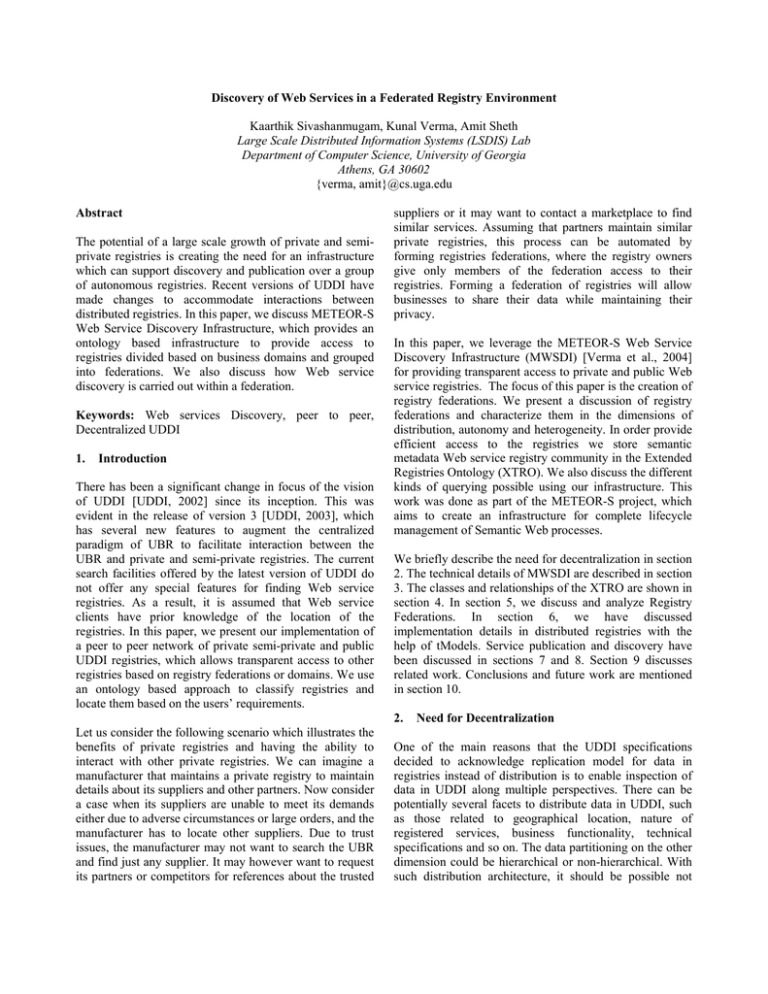
Discovery of Web Services in a Federated Registry Environment
Kaarthik Sivashanmugam, Kunal Verma, Amit Sheth
Large Scale Distributed Information Systems (LSDIS) Lab
Department of Computer Science, University of Georgia
Athens, GA 30602
{verma, amit}@cs.uga.edu
Abstract
The potential of a large scale growth of private and semiprivate registries is creating the need for an infrastructure
which can support discovery and publication over a group
of autonomous registries. Recent versions of UDDI have
made changes to accommodate interactions between
distributed registries. In this paper, we discuss METEOR-S
Web Service Discovery Infrastructure, which provides an
ontology based infrastructure to provide access to
registries divided based on business domains and grouped
into federations. We also discuss how Web service
discovery is carried out within a federation.
Keywords: Web services Discovery, peer to peer,
Decentralized UDDI
1.
Introduction
There has been a significant change in focus of the vision
of UDDI [UDDI, 2002] since its inception. This was
evident in the release of version 3 [UDDI, 2003], which
has several new features to augment the centralized
paradigm of UBR to facilitate interaction between the
UBR and private and semi-private registries. The current
search facilities offered by the latest version of UDDI do
not offer any special features for finding Web service
registries. As a result, it is assumed that Web service
clients have prior knowledge of the location of the
registries. In this paper, we present our implementation of
a peer to peer network of private semi-private and public
UDDI registries, which allows transparent access to other
registries based on registry federations or domains. We use
an ontology based approach to classify registries and
locate them based on the users’ requirements.
suppliers or it may want to contact a marketplace to find
similar services. Assuming that partners maintain similar
private registries, this process can be automated by
forming registries federations, where the registry owners
give only members of the federation access to their
registries. Forming a federation of registries will allow
businesses to share their data while maintaining their
privacy.
In this paper, we leverage the METEOR-S Web Service
Discovery Infrastructure (MWSDI) [Verma et al., 2004]
for providing transparent access to private and public Web
service registries. The focus of this paper is the creation of
registry federations. We present a discussion of registry
federations and characterize them in the dimensions of
distribution, autonomy and heterogeneity. In order provide
efficient access to the registries we store semantic
metadata Web service registry community in the Extended
Registries Ontology (XTRO). We also discuss the different
kinds of querying possible using our infrastructure. This
work was done as part of the METEOR-S project, which
aims to create an infrastructure for complete lifecycle
management of Semantic Web processes.
We briefly describe the need for decentralization in section
2. The technical details of MWSDI are described in section
3. The classes and relationships of the XTRO are shown in
section 4. In section 5, we discuss and analyze Registry
Federations. In section 6, we have discussed
implementation details in distributed registries with the
help of tModels. Service publication and discovery have
been discussed in sections 7 and 8. Section 9 discusses
related work. Conclusions and future work are mentioned
in section 10.
2.
Let us consider the following scenario which illustrates the
benefits of private registries and having the ability to
interact with other private registries. We can imagine a
manufacturer that maintains a private registry to maintain
details about its suppliers and other partners. Now consider
a case when its suppliers are unable to meet its demands
either due to adverse circumstances or large orders, and the
manufacturer has to locate other suppliers. Due to trust
issues, the manufacturer may not want to search the UBR
and find just any supplier. It may however want to request
its partners or competitors for references about the trusted
Need for Decentralization
One of the main reasons that the UDDI specifications
decided to acknowledge replication model for data in
registries instead of distribution is to enable inspection of
data in UDDI along multiple perspectives. There can be
potentially several facets to distribute data in UDDI, such
as those related to geographical location, nature of
registered services, business functionality, technical
specifications and so on. The data partitioning on the other
dimension could be hierarchical or non-hierarchical. With
such distribution architecture, it should be possible not
only to locate appropriate registry (by processing all kinds
of data distribution facets and data partitioning criteria) but
also to aggregate search results from different candidate
registries. Replication was chosen in UDDI because
creating a scalable model for distribution of data is
inherently difficult. However, in version 3 of the UDDI
specifications, the need for data partitioning and affiliation
among registries have been acknowledged. In MWSDI, we
advocate data distribution (as opposed to data replication)
and support any kind of data distribution among multiple
registries1. The data partitioning criteria is stored in the
Extended Registries Ontology (XTRO) in MWSDI.
3.
MWSDI
In this section, we briefly describe the conceptual
foundations and implementation of MWSDI which
provides the infrastructure for the work presented in this
paper. Detailed descriptions of the architecture,
implementation and protocols can be found in [Verma et
al., 2004]. The aim of MWSDI is to provide clients with an
efficient publication and discovery mechanism in a multi
registry environment. We use semantic metadata stored in
the XTRO to identify appropriate registries and direct the
queries to them. Each time, a new registry is added to
MWSDI, the XTRO is updated with the relevant details of
the new registry. We show the interaction of MWSDI,
registries and clients in Figure 1.
We have implemented MWSDI as a peer to peer network.
Based on the different kinds of functionality, we have
implemented different peer types. They are the following.
Gateway Peer: Gateway Peer acts as an entry point for
registries to join MWSDI. It is responsible for updating the
XTRO when new registries join the network. Gateway
Peer is the only peer that can update the XTRO or initiate
new peers. It is also responsible for propagating any
updates in the XTRO to all the other peers.
Operator Peer: The role of the Operator Peer is to operate
a UDDI registry and to provide Operator Services for its
registry. Operator Services are the value added services
like semantic discovery and publication of Web services,
provided by the registry operators. The Operator Peer also
acts as a provider for the XTRO to all other peers who
need it.
Auxiliary Peer: Auxiliary Peers act as providers of the
XTRO to make it highly available which is critical to the
performance of the infrastructure. In event of failure of the
Gateway Peer, one of the auxiliary peers starts to act as the
Gateway peer.
Client Peer: The Client Peers are transient members of the
peer-to-peer network, as they are instantiated only to allow
users to utilize the capabilities of the MWSDI.
MWSDI has been implemented on a cluster of SUN
workstations as peer to peer network using the JXTA
[JXTA] framework. Any peer can be a JXTA peer if it
implements one or more JXTA protocols. While there are
a number of such protocols, we have used the Peer
Discovery Protocol and the Pipe Binding Protocol. In
addition to the protocols available in JXTA framework we
have implemented two MWSDI specific protocols. They
are:
Operator Peer Initiation Protocol: It defines the protocol
involved in adding a new registry to the MWSDI system. It
involves creating a new registry instance in XTRO. In
some cases it may involve creating new federation or a
domain.
Client Peer Interaction Protocol: It defines the protocol
for accessing registries for publication and discovery.
Details of these protocols are available in [Verma et al.,
2004].
4.
Figure 1: Interaction of MWSDI with clients and
registries
1
Our prototype implementation is tested with nonhierarchical distribution of data. Data replication is also
supported using the “replicateOf” relationship in XTRO.
Extended Registries Ontology (XTRO)
In our initial, naïve implementation registries could only
be categorized based on business domains. We did not
create constructs for creating registry federations. The
Registries Ontology in our initial implementation is
extended (and called as Extended Registries Ontology or
XTRO) in this work that supports complex classification
as well as Registry Federations. Extended Registries
ontology (XTRO), represented in OWL, is a
comprehensive ontology containing details of Domains,
Registries, Ontologies and Registry Federation and
network of relationships among them. All the classes and
few important object properties in XTRO are shown in
Figure 2.
Registry
Federation
•
What are the available relationships between the
registry R and registry S?
With the use of such queries and their combination thereof
to construct more complex queries, multi-perspective and
intelligent querying can be carried out to locate registries
for publishing or discovering Web services. We have
shown a visualization of the XTRO in Figure 3.
memberOf
belongsTo
Registry
supports
Ontology
Domain
consistsOf
belongsToDomain
subDomainOf
Figure 2: Classes and their Relationships in XTRO
Let us briefly examine the classes and their relationships
shown in Figure 2. Each registry in the network is an
instance of the class Registry. Different business domains
are represented as instances of the class Domain.
Ontologies available in MWSDI are instances of class
Ontology and registry federations in MWSDI are instances
of the class RegistryFederation. Instances of Registry and
RegistryFederation can belong to one or more domains. A
Domain instance has a number of Ontology instances to
describe it. A Registry instance can support one or more
domain ontologies and a Domain is usually a
specialization of a more generic Domain. Each class has a
number of attributes which give us more information about
their instances. We have not included them in this paper
for brevity. This simple set of classes and relationships
provides a simplified but exhaustive view of the Web
service registry community which can be used for efficient
and accurate selection of registries. The XTRO allows us
to maintain information and provide answers for the
following type of queries to identify one or a group of
registries:
• What is the access URL, available data model or
type of the registry R?
• Does the registry R support the ontology O?
• Which are the registries available under the business
domain B?
• Is the registry X a member of the registry federation
Y?
• Which registries pertain to the domains that support
the ontologies O1 and O2?
• Get all the registry federations that belong to the
domain D?
• Find all the registries that are categorized under the
node N in the taxonomy (or ontology) C?
Figure 3: Visualization of XTRO
5.
Registries Federation
We define a Registry Federation to be a collection of
autonomous but cooperating Web service registries. The
goal of a federation can be forming a registry community
serving either a business domain or forming a market place
of registries with similar but competing services. A
federation can also aim to form an association of registries
with interdependent services bound by trust and common
network identity for confident collaboration. It can be a
collection of private registries, public registries or even
electronic marketplaces. The members of the registry
federation can be heterogeneous and can have different
data models and access APIs. A registry can participate in
more than one federation. In the following sections, we
explore the benefits of federations and characterize them
with respect to the dimensions of distribution,
heterogeneity and autonomy. Some of the the following
issues have not been discussed by us in this paper.
•
•
•
Comparison of the different federation models.
Proposition of an architecture to establish
interoperation
between
data
models
of
heterogeneous Web service registries like UDDI
and ebXML.
Analysis or implementation of typical features
needed in a federation (like identity management,
trust/contract issues and business aspects).
5.1. Need for Creating Registry Federations
5.2.2.
Federation of registries can provide several advantages
over individual registries. The benefits of a typical
federated system include, but are not limited to the
following:
• Managing distributed information infrastructure
(sharing data, establishing inter-system data
references/dependencies) without integrating the
information into a single system.
• Accessing and integrating information from
disparate systems without having to hop around
these information repositories and manually
integrate the information from each. It also helps in
achieving data model transparency.
• Providing a scalable approach in accommodating
new information sources to the existing applications
independent of the technology, data structure, API
or version of the information source.
• Providing value added services (like common
authentication/authorization
methods,
QoS
provisioning, interfaces to specify query and
information integration rules).
The registries in a federation may display two types of
heterogeneity,
namely
structural
and
semantic
heterogeneities.
Structural
heterogeneity
includes
difference in data model. For example, an ebXML or a
UDDI registry can be used as a Web service registry each
with different data model. Within the same registry
specification, registries could expose difference in terms of
the data model and/or API versions they support. Semantic
heterogeneity includes semantic differences in the
elements of the data model. A typical federation allows the
coexistence of the registries in a mutually beneficial and
harmonious fashion in spite of the exhibited
heterogeneities.
5.2. Characteristics of Registries Federation
The dimensions of distribution, heterogeneity and
autonomy used for characterizing different types of
federations of database systems where discussed in [Sheth
and Larson 1990]. The same dimensions can be used to
discuss characteristics of federation of registries. This
work is not an attempt to discuss the intricate details of
these characteristics. For the sake of clarity and
completion, we have provided a brief description.
5.2.1.
Data Distribution
Data may be distributed across several UDDI registries
either in hierarchical or non-hierarchical models. This
means that the entries in a UDDI need not be duplicated in
all other registries. Current UDDI standard conforms to
replication model, where all registries are equal and each
registry is an exact and complete replica of each other.
Hence executing a query in a registry would return the
same result as that of executing the same query in another
registry. Several researchers [Thaden et al., 2003, Schmidt
and Parashkar, 2003] have argued that this kind of
replication is not scalable. These research works also argue
that distributing data among multiple registries based on
vertical or horizontal partitions would provide increased
availability and reliability.
5.2.3.
Structural and Semantic Heterogeneity
Autonomy
The registries in the federation will typically be
autonomous. As a result, a registry operator may have a
separate and independent control over his registry. Though
autonomy could be described for various criteria there are
two basic types of autonomy based on which registries
could be defined. There are:
• Design autonomy: This includes selection of data
model, API selection and different types of access,
different algorithms for semantic publication and
discovery.
• Execution autonomy: A registry may be able to
support publication and discovery of Web services
independent of other registries in the federation.
Hence the publication and discovery mechanisms in
a registry may be unaffected by whether or not a
registry is a part of a federation.
We characterize the federations supported by MWSDI in
the following manner. Our implementation allows data
distribution with the help of XTRO. We support design
autonomy as different registries can have different
algorithms for semantic publication and discovery. We
also support execution autonomy as registries in MWSDI
can be accessed in a standalone manner without using any
MWSDI components. We support limited form of
semantic heterogeneity in the federation with the help of
tModel directories discussed in the next section. However,
we do not support structural heterogeneity, as we only
support UDDI registries.
6.
TModels, UDDI Registry and Federation of UDDI
Registries
TModels are reusable metadata constructs in UDDI data
structure that are used to characterize and categorize
businesses and their services. TModels provide the ability
to describe compliance with a specification, a concept or a
shared understanding. One of the main uses of a tModel is
to define abstract namespace references. This means that a
tModel can act as a reference that represents a relationship
between keyed name-value pair and a namespace where
the name-value pair has a meaning. With this
characteristic, tModels are useful to annotate or attach
categorization and identification information to the UDDI
data. MWSDI utilizes this feature of tModels to add
semantic annotations to the UDDI entries. Once tModels
are registered to represent an idea or shared meaning and
the annotations are added to the UDDI data using the
registered tModels, the reference (tModel keys) to the
tModels can be used to discover information in UDDI that
are associated with the tModels. However, to perform
matching based on keyed references, the tModel keys have
to be specified. As a result, a query directed to UDDI
registry cannot be used to query another registry. This is
because, even if the same idea or shared specification is
registered in two different registries as tModels, the
tModel keys could (and in most cases it will) be different.
Hence, to run a query across multiple UDDI registries,
some kind of query parameter translation has to be done to
ensure uniform semantic interpretation of the query across
all the registries. Query parameter translation in MWSDI
involves translating the tModel keys used in the query. If
the query sent to registry R1 references to a tModel TM1
(with the key TK1) with a value V1 (in the name-value
pair), representing a concept C1 in a taxonomy, ontology
or some other shared specification, then to run the same
query in another registry R2 without altering the query
semantics, we have to replace the key TK1 in the query
with a corresponding key TK2 which is an identifier (key)
for the tModel TM2 (in R2) representing the same concept
C1. The value V1 should not be changed to retain the
semantics of the original query. Our implementation of
federation of registries is based on the idea of maintaining
mapping between tModel keys of tModels with same
semantics across multiple registries and to use it for
federated search.
In MWSDI, each federation will have a tModel directory.
The tModel directory is a simple special purpose UDDI
registry that registers only tModel related data. For every
unique tModel across the registries in the federation, there
will be a representative tModel registered in the tModel
directory. Each of the representative tModel stores
mapping between registries and the corresponding tModel
keys. For example, if there are three registries in the
federation namely R1, R2 and R3 and if there is a tModel
representing an ontology is published across these
registries with three different keys TK1, TK2 and TK3
respectively, then the tModel directory will have a
representative namespace tModel that stores the mapping
R1-TK1, R2-TK2 and R3-TK3. If there is a query that is
sent to the registry R2 referring to the tModel key TK2,
then to run the same query in the registry R1, the key TK2
in the query is replaced with TK1 and to run the query in
the registry R3, TK2 is replaced with TK3. Figure 4 shows
the structure of a sample representative tModel. It is
categorized as a namespace tModel. It also stores generic
name-value pairs to store mappings between registries and
the keys of the tModels (in these registries) that are linked
by the representative tModel.
Figure 4: Representation of TModel Structure
6.1. Implementation of TModel Directory
Whenever a tModel is registered in the tModel directory as
a representative of a tModel appearing in different
registries with different keys, it will be categorized as a
namespace tModel using the taxonomy value “namespace”
in relation with one of the built-in core UDDI tModels
which has the name “uddi-org:types”, tModel key
“uuid:C1ACF26D-9672-4404-9D70-39B756E62AB4”. A
keyed reference is constructed with this tModel key and
the name-value pair is used for this categorization. The
purpose of this categorization is to have the namespace
functionality and to find all the representative tModels in
the tModel directory that belong to a particular namespace.
The representative tModel will also be categorized using
another core built-in tModel with the name “uddiorg:general_keywords”, tModel key “uuid:A035A07CF362-44dd-8F95-E2B134BF43B4” that is used to store
generic name value pairs. The name value pair represents
the registry name and the key of the tModel in the registry
that is associated with the representative tModel
6.2. Administration of the Federation
Federation of Registries can take place in two different
ways. One way is to form the federation first, allowing
only empty (non-populated or un-used) registries to join
the federation wherein data in the registries are populated
later and the other way is to form the federation that allows
both used and un-used registries to join the federation.
Version 3 specification of UDDI supports the former to
establish affiliation between multiple registries with
appropriate policies to allow controlled copying of data
structures among them. These registries share a common
namespace for entity keys for the purpose of entity
promotion and hence if a tModel has to be published in
more than one registry it can be published with the same
tModel key in all the affiliated registries. This kind of
affiliation makes it practically difficult for a registry to be
a part of more than one independent affiliation because
namespace consistency for the keys are difficult to enforce
across independent affiliations. In MWSDI, we support
both ways of establishing registries federation. In addition
our implementation can support building federation using
any version of UDDI registry as the implementation uses
core UDDI data structure (tModels mainly) and nothing
outside of it. Also, it empowers a registry to take part in
more than one federation as the membership of a registry
in a federation does not affect its other operations
including key assignment for its data. The unique feature
about our federation is that a registry can arbitrarily join or
leave the federation without affecting other registries or
without affecting the existing applications that are
dependent on keys of the UDDI data.
In MWSDI, the registries join federation one by one.
When the first registry (say R1) which probably will be the
initiator of the federation joins the federation, all the
tModels in the registry are treated unique (i.e. unique
overviewURLs are assumed). For every tModel in the
registry that joins the federation, a representative tModel is
registered in the tModel directory of the federation. Each
of the representative tModel is categorized as namespace
tModel. As the overview URL of each tModel (in R1) is
unique, the namespace keyed reference in the category bag
of the corresponding representative tModel can be used to
hold this URL in the name-value pair. Each of the
representative tModel is also categorized using a keyed
reference
(in
conjunction
with
“uddiorg:general_keywords” taxonomy) representing the
mapping between R1 and the key of the corresponding
tModel in this registry. Hence a tModel (in R1) identified
by TK1 will have a representative in the tModel directory
that is categorized using the mapping R1-TK1. It should be
noted that the structure of the tModels are not copied from
the federation member to the tModel directory. The
mapping in the directory acts as a pointer to the tModel in
R1. When another registry (say R2) joins the federation,
overview URL of each tModel is compared against the
value (in name-value pair) of all the namespace keyed
references in the directory. If, for a tModel (in R2) with
key TK2, there is any existing namespace keyed reference
for a representative tModel (in tModel directory), then a
keyed reference representing the mapping between R2 and
TK2 is added to the existing categorization of the
representative tModel., Consider a representative tModel
that already has the mapping between the registry R1 and
the tModel with key TK1. After the federation figures out
that the equivalent tModel in R2 has the key TK2, the
system will add another keyed reference to represent the
mapping between the registry R2 and the tModel with key
TK2. In this way a tModel registered across multiple
registries are linked using one representative tModel that is
characterized using the name-value pair Rx-TKx where Rx
represents a registry that hosts the tModel with a key TKx.
After the federation is formed, whenever a tModel is
published in one of the member registries, a similar step is
undertaken to ensure updated mapping details between
registries and tModel keys. Deleting a tModel in a registry
removes a corresponding keyed reference in the category
bag of the representative tModel in the directory.
7.
Service Publication in a MWSDI-2G
Service publication in MWSDI involves the following
steps.
Creating Service Advertisements: Annotation of WSDL
files with the help of ontologies has been discussed in
[Patil et al., 2004; Sivashanmugam et al., 2003]. Users can
publish annotated or standard WSDL files using the client
peers.
Registry Selection: In case of standard WSDL files, the
user is required to manually specify the requirements for
registry selection using the GUI tool shown in Figure 6.
For semantic publication of Web services, the users can
specify either the federation names or business domains.
We have added the functionality in MWSDI to
automatically determine the registries on the basis of this
information and ontologies used for annotation. A registry
selection query can be expressed as R, where
R = <f, d, o, r> and f corresponds to the names of the
registry federations, d corresponds to the business
domains, o corresponds to set of ontologies, and r
corresponds to a set of registry relationships. Let us
assume that a particular query has the following values
R = < {F1,F2}, {D2, D3}, {O1, O2, O3, O4}, {} >
The results of such a query are shown in Figure 5. The
registries are shown categorized in Federations F1, F2 and
F3 as well as domains D1, D2 and D3. The shaded
registries are results of the query. Some registries in the
appropriate domains and federations are not selected as
they do not support the ontologies in the query. Even
though registry relationships have not been shown in the
sample query, relationships of registries like belongsTo
and partnerOf can be used to select more registries. We
use the inference capabilities provided by SNOBASE [Lee
et al., 2003] for the handling the queries.
Service Publication: The services are the published by
sending the advertisements to the operator peers of the
selected registries.
8.
Figure 5: Selection of Registries
The GUI tool for constructing the query R is shown in
Figure 6. The initial set of domains selected from browsing
XTRO is shown in the top left panel. We provide the users
with the option of filtering the domains before adding them
to the query. The final selection of domains is shown in the
top right panel. The available relationships between
domains and registries and shown in the bottom left panel.
Other dimensions of the query, namely ontologies,
federations and inter registry relationships can be specified
using the tabs shown in Figure 6.
Figure 6: GUI tool for Constructing Registry Selection
Query
Service discovery in MWSDI-2G
MWSDI supports both semantic and syntactic discovery of
services. Service discovery in MWSDI-2G involves
following steps:
Creating Search Templates: Users can either use the
search mechanism provided by UDDI or create semantic
templates. We have discussed semantic templates in
[Sivashanmugam et al., 2003;Sivashanmugam et al.,
2003a]
Registry Selection: Registry selection is the same as
discussed in the previous section on publication.
Query Execution: The service templates are then sent to
the operator peers of the selected registries. We have
provided an option of creating a “federated query”. In case
of the federated query, the TModel directory is used to
translate and propagate the query to other registries in the
federation.
Result aggregation: The operator peers return all the
results to the client peer.
9.
Related Work
The approaches to Web services discovery can be
classified as centralized and decentralized. UDDI falls
under fully centralized approach that supports replication.
Having realized that replicating the UDDI data is not a
scalable approach several decentralized approaches have
been proposed. [Thaden et al., 2003] argues that the trend
in integrating UDDI features into general purpose
enterprise registries results in rapid increase of private
registries and limits the use of public registries. It also
states that, from discovery perspective, it is impractical to
replicate these private registries in the public counterparts.
They propose to deal with this problem by creating a
virtual global registry by connecting all private registries
in a P2P network. They also support semantics based
service discovery using DAML-S service descriptions and
matchmaking. This work is similar to our work but they do
not consider registry federations. [Schlosser et al., 2002]
details the use of a global ontology to determine the
organization of peers in their P2P topology thus enabling
concept based search. It is about ontology based clustering
of peers based on their capabilities. P2P based web service
discovery is also discussed in [Schmidt and Parashkar,
2003; Paolucci et al., 2003; Maedche and Staab, 2003].
None of the aforementioned works considers relationships
between registries and registry federations and routing
queries on the basis of them. Our work is different as due
we use XTRO to capture relationships among registries as
well caterorize the registries on the basis of business
domains.
[Zhou et al., 2003] presents an federated architecture that
supports QoS based discovery of services. It has a notion
of UX ("UDDI Extension") server that performs federated
discovery on behalf of a user request and aggregates
results before sending them back to the requestor. The
paper discusses different ways of maintaining links
between the servers and how query is propagated. It also
envisions linking UX servers across different domains. It
points out that improvements could be made using
semantic descriptions and matchmaking. In our approach,
we have used JXTA and abstracted the network level
issues. The emphasis is rather on utilizing UDDI data
structure to store semantic description of a service for
better service matchmaking, to establish a federation for
carrying out discovery process in multiple registries and in
exploiting an ontology for improving the registry selection
mechanism for Web service publication and discovery.
Looking from a business perspective our work shares that
the perspective of [Christoffel, 2001]. It emphasizes the
idea of increasing the potential of individual traders by
cooperation with other traders. It also argues that
cooperation between traders can be useful when a trader
cannot provide sufficient service to a customer. It also
discusses the use of centralized and non-centralized
federations. Our work applies this idea to Web service
registries and argues the use of cooperation of registries
where in registries can work together as a federation to get
useful results during Web service discovery. Due to
existence of tModel directory in federations, our federation
can be termed as centralized federation. Federated Web
service discovery is discussed in [Chandana et al., 2003].
However, it is limited to keyword based search on a
predefined set of UDDI registries. Business Explorer for
Web Services (BE4WS) [BE4WS, 2001] is an XML-based
UDDI exploring engine to perform complex searches using
a single query request on a single or multiple UDDI
Registries. It does not however support tModel translation
while performing a query across multiple registries as
discussed in our work.
10. Conclusion and Future work
In this paper we discussed how the metadata of a registry
network stored in an ontology (XTRO) can be used in
registry selection to perform Web service publication or
discovery. [UDDIDS, 2002] says that data in UDDI is not
sufficient to provide searches to find partners with
products based on price range or availability, or to find
high quality partners. With XTRO as a common resource
in the P2P based architecture and the support for semantics
based publication and discovery of Web services in
MWSDI, it would be possible for applications, businesses,
partners and suppliers to analyze information about the
registries and their characteristics to effectively carry out
the process of service discovery.
In the future we intend to extend this work to incorporate
the following:
• Establishing contracts, trust and security policies
among members of the federation
• Mediator to enhance interaction between federations
• Dynamic/Runtime association between registries
References
[BE4WS, 2001] Business Explorer for Web Services,
http://www.alphaworks.ibm.com/tech/be4ws
[Chandana et al., 2003] C. Subasinghe, D. Cooray, N.
Sadeep, L. Kumara, Wonder Room for Easy Web Services
Invocation, Department of Computer Science and
Engineering University of Moratuwa, December 2003.
[Christoffel, 2001] M. Christoffel. Cooperations and
Federations of Traders in an Information Market. In
Proceedings of the AISB Symposium Intelligent Agents in
Electronic Commerce, York, 2001.
[JXTA] http://www.jxta.org
[Lee et al., 2003] J. Lee , R. Goodwin, R. Akkiraju, P.
Doshi, Y. Ye 2003 SNoBASE: A Semantic Network-based
Ontology Ontology Management.
http://alphaWorks.ibm.com/tech/snobase.
[Maedche and Staab, 2003] A. Maedche, S. Staab.
Services on the Move - Towards P2P-Enabled Semantic
Web Services. In: Proceedings of the 10th International
Conference on Information Technology and Travel &
Tourism, ENTER 2003, Helsinki, Finland, 29th-31st
January 2003.
[Paolucci et al., 2003] M. Paolucci, K. Sycara, T.
Nishimura, and N. Srinivasan, "Using DAML-S for P2P
Discovery," in Proceedings of the First International
Conference on Web Services (ICWS'03), Las Vegas,
Nevada, USA, June 2003, pp 203- 207 .
[Schlosser et al., 2002] M. Schlosser, M. Sintek, S. Decker
and W. Nejdl. A Scalable and Ontology-Based P2P
Infrastructure for Semantic Web Services. Second
International Conference on Peer-to-Peer Computing
(P2P’02) September 05-07, Linkoping, Sweden 2002.
[Schmidt and Parashkar, 2003] A Peer-to-Peer Approach
to Web Service Discovery, C. Schmidt and M. Parashar,
World Wide Web, Internet and Web Information Systems,
Kluwer Academic Publishers, August 2003.
[Sivashanmugam et al., 2003] K. Sivashanmugam, K.
Verma, A. Sheth, J. Miller, Adding Semantics to Web
Services Standards, Proceedings of the 1st International
Conference on Web Services (ICWS'03), Las Vegas,
Nevada (June 2003) pp. 395-401.
[Sivashanmugam et al., 2003a] K. Sivashanmugam, J.
Miller , A. Sheth, K. Verma 2003. Technical Report 03008, LSDIS Lab, Computer Science Dept., University of
Georgia.
[Thaden et al, 2003] U. Thaden, W. Siberski, and W.
Nejdl, A Semantic Web based Peer-to-Peer Service
Registry Network, Technical Report, Learning Lab Lower
Saxony,
[UDDI, 2002] Evolution of UDDI, White Paper available
at http://www.uddi.org/pubs/the_evolution_of_uddi_2002
0719.pdf
[UDDIDS, 2002] UDDI Version 2.03 Data Structure
Reference, UDDI Committee Specification, 19 July 2002
http://uddi.org/pubs/DataStructure-V2.03-Published20020719.htm
[UDDI, 2003] UDDI Version 3.0.1, available
http://uddi.org/pubs/uddi-v3.0.1-20031014.htm
at
[Verma et al., 2004] K. Verma, K. Sivashanmugam, A.
Sheth, A. Patil, S. Oundhakar and J. Miller, METEOR–S
WSDI: A Scalable Infrastructure of Registries for
Semantic Publication and Discovery of Web Services,
Journal of Information Technology and Management (to
appear, 2004)
[Zhou et al., 2003] Zhou Chen, Chia Liang-Tien, Bilhanan
Silverajan and Lee Bu-Sung, UX- An Architecture
Providing QoS-Aware and Federated Support for UDDI,
In proceeding of the first International Conference on Web
Services(ICWS03), 2003

